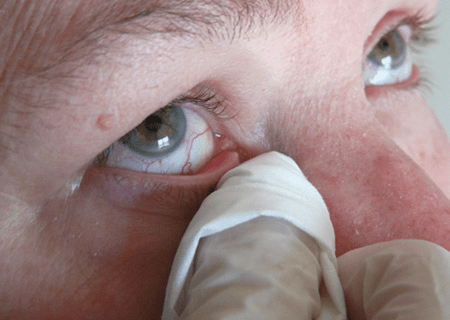A lens opacity that distorts the image projected onto the retina.
Cataract
A condition in the eye that occurs with increased pressure and resulting hypoxia of photoreceptors and their synapsing nerve fibers.
Glaucoma
Retinal disorder described as mild blurring and visual distortion
Macular degeneration
Corneal disorder described as degeneration of corneal tissue resulting in abnormal corneal shape, which requires surgical management.
Keratoconus
After seeing the ophthalmologist, the patient is scheduled for cataract surgery. What preoperative teaching will the nurse provide?
A. Expect vision to be improved immediately following surgery.
B. Inform that reading glasses will not be necessary after cataract removal.
C. Plan for administration of different types of eye drops prior to having surgery.
D. Avoid wearing dark glasses because the retina needs a direct source of light for best vision.
C. Plan for administration of different types of eye drops prior to having surgery.
List two early signs of cataracts
slightly blurred vision and decreased color perception
Early signs of primary glaucoma?
These vision issues are examples of what type of error of the eye?
Myopia
Hyperopia
Presbyopia
Astigmatism
Refraction
What is keratoplasty?
Corneal transplant. The surgical removal of diseased corneal tissue and replacement with tissue from a human donor cornea.
After recovery of cataract surgery, the nurse provides postoperative teaching for the patient. Which client statement indicates a need for further teaching by the nurse?
A. "Aspirin will help decrease discomfort"
B. "I will wear dark sunglasses to protect my eyes"
C. "My daughter will help me if I need to lift something"
D. "The surgeon needs to know if I experience reduced vision"
A. "Aspirin will help decrease discomfort"
True or False?
No pain or eye redness is associated with age related cataract formation?
True
Late signs of glaucoma that often occur after irreversible damage to optic nerve function
seeing halos, losing peripheral vision, decreased visual sensory perception not improved by glasses.
Disorder caused by retinal nerve cell degeneration with pigmented cell growth.
Retinitis pigmentosa
an opaque, bluish-white ring within the outer edge of the cornea, is caused by fat deposits
Arcus senilis
After cataract surgery, a client is brought to the recovery area. The nurse is preparing to administer eye drops and other medications. Which order should the nurse question?
A. Warfarin
B. Steroid ophthalmic
C. Antibiotic ophthalmic ointment
D. Acetaminophen with oxycodone
A. Warfarin
What is the only treatment for cataracts and is performed as soon as possible after vision is reduced and ADLs are affected?
Surgery
True or False?
Most eye drops cannot be absorbed systemically?
False
Most eyedrops used for glaucoma therapy can be absorbed systemically and cause systemic problems. It is critical to teach punctal occlusion to patients using eyedrops for glaucoma therapy

What are the signs and symptoms of retinitis pigmentosa?
night blindness, loss of peripheral vision, heavy pigmentation
The nurse is caring for 4 clients. Which does the nurse identify that is at the greatest risk for developing vision disturbances?
A. 29 year old who plays sports
B. 39 year old who uses a computer for work
C. 50 year old with rheumatoid arthritis
D. 62 year old with hypertension
D. 62 year old with hypertension
What will the patient need to do pre-op and post-op for cataract surgery?
Perform self eye exams and instill several types of eye drops.
What is the primary post op concern after and eye surgery?
Hemorrhage
What assessment finding does the nurse anticipate in a client who has just undergone surgery for cataract removal?
A. Yellowish drainage and photo phobia
B. Mild itching and bloodshot appearance
C. Pain accompanied by nausea and vomiting
D. Change in visual acuity with tearing and redness
B. Mild itching and bloodshot appearance
What class of drugs will be questioned after cataract surgery?
Anticoagulants
What finding does the nurse anticipate when assessing a client with a new diagnosis of glaucoma?
A. Seeing “shooting stars”
B. Decrease in central vision
C. Gradual loss of visual fields
D. Abrupt onset of excruciating pain
C. Gradual loss of visual fields
Which priority intervention will the nurse provide when caring for an older adult client with vision problems?
A. Write names and indications of medication on prescription bottles
B. Ensure adequate, non-glare lighting in the room
C. Review the medication administration record for artificial tears
D. Provide written and verbal instructions when giving discharge teaching.
B. Ensure adequate, non-glare lighting in the room
Which client statement affirms that nurse teaching about instillation of multiple different eyedrops has been effective? Select all that apply.
A. “It will be very easy for me to instill all of the drops at one time.”
B. “A schedule will help me remember when to instill the eyedrops.”
C. “If I have trouble instilling the drops, there are devices that can be helpful.”
D. “I can label the eyedrops by color to help me easily distinguish which one is which.”
E. “I will not touch the droppers to my eyes as this can cause contamination and infection.”
B, C, D, E